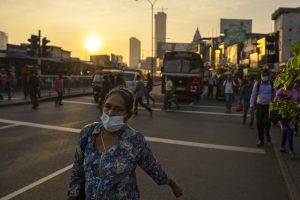Efforts to restore Sri Lanka’s shattered economy and instill some confidence in government is proving just as difficult as many were predicting in mid-2022, when thousands of protestors stormed the presidential palace and ousted President Gotabaya Rajapaksa.
On the streets, people were justifiably fed-up as fuel imports ground to a halt. Essential items, including rice and medical supplies, were nearly impossible to obtain. Consumers were restricted to one tub of butter per day and the price of imported tinned pears hit about $10.
The country had defaulted on its $51 billion foreign debt, headline inflation was at 70 percent, lending rates were above 15 percent, and economic growth for the second quarter of the calendar year was at a staggering negative 8.4 percent.
Sri Lankan economist and senior research associate with ODI Global in London, Ganeshan Wignaraja, says life in Sri Lanka has improved since images of protestors taking a dip in the president’s swimming pool were flashed around the world.
“Today, there is some normalcy on the economic and political front,” he said, adding that President Ranil Wickremesinghe deserves respect for negotiating a $2.9 billion bailout with the International Monetary Fund (IMF) and assurances from major lenders China, Japan, and India.
In a bid to rebuild the balance sheet, Sri Lanka will slash its army by a third to 135,000 personnel by next year and to 100,000 by 2030. Each ministry has been told to cut spending by five percent, and India has loaned the island-state about $4 billion in food and financial assistance.
This included $1.5 billion for imports and $3.8 billion in currency swaps and credit lines. Sri Lankan Telecommunications and Sri Lankan Airlines are expected to be privatized.
“Paris Club countries like Japan agreed early on. India has just agreed and there are rumors that China will also give its assurances soon. Once all the assurances are in, IMF Board approval could happen in a matter of months,” Wignaraja added.
He said then the real hard work starts with restructuring the country’s foreign debt and implementing the IMF program.
“The revenue based fiscal consolidation will increase taxes, trim expenditure, privatize state owned enterprises, and make the Central Bank more independent. Also economic reforms are needed to cut red tape regulations and make the economy more outward-oriented,” he said.
“But it will take some time for recovery to take hold due to a cost of living crisis facing the population, political discontent and a lack of foreign exchange for imports. The economy could stabilize in 2024.”
Sri Lanka owes China more than $6 billion, or about 10 percent of its external debt, after heavy investments in the Hambantota Port and the Colombo Port City among other infrastructure projects and Beijing has been accused of dragging its feet in resolving the debt crisis.
However, China – and for that matter India, Japan, and the IMF – are unlikely to heed calls from 182 economists who, on January 23, urged a cancellation of Sri Lanka’s debt.
It’s a contentious point for the Rajapaksa clan, which rose to prominence by ending Sri Lanka’s 26-year civil war, winning political power, and engaging China throughout, much to the annoyance of India and Japan. Their problems are mounting.
Sri Lankan courts have ruled that Gotabaya, his brothers Mahinda, a former president, and Basil, a former finance minister, could be prosecuted for economic crimes and their fall from grace has also emboldened separate efforts to hold them responsible for war crimes.
On January 10, Canada sanctioned Gotabaya and Mahinda for committing “gross and systemic violations of human rights” towards the end of the conflict in 2009 when, according to the United Nations, at least 40,000 Tamil civilians were killed. Two others were also sanctioned.
“The military bombarded hospitals and self-declared ‘no fire zones,’ killing and wounding thousands of Tamil civilians. Many captured combatants and civilians were forcibly disappeared and remain missing,” Human Rights Watch said last week.
Additionally, the Committee to Protect Journalists has also noted that 13 journalists were killed between 2005 and 2015 when Mahinda presided, “over a systematic assault on the press”.
These issues are gaining as much steam as the economic crisis and will command much attention over the months and years to come if Sri Lanka is to restore its lost pride.

































